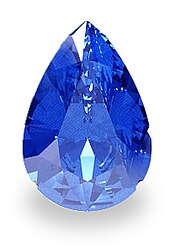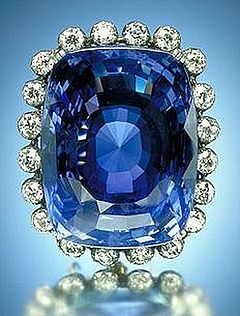|
GIA Certified 9.45ct SAPPHIRE PLATINUM Ring - R9511
|
|---|
|
This Platinum ring is set with a centered oval Sapphire surrounded by smaller Diamonds. Main Stone: Sapphire Main Stone Weight: 9.45ct Secondary Stone: Diamond Secondary Stone Weight: 3.56ct Metal: Platinum Metal Purity: 900 parts per 1000 Store Reference#: R9511

Sapphire
Sapphire is a gemstone, a variety of the mineral corundum, an aluminium oxide (?-Al2O3). It is typically blue in color, but natural "fancy" sapphires also occur in yellow, purple, orange, and green colors; "parti sapphires" show two or more colors. The only color which sapphire cannot be is red - as red colored corundum is called ruby,[2] another corundum variety. This variety in color is due to trace amounts of elements such as iron, titanium, chromium, copper, or magnesium. Commonly, natural sapphires are cut and polished into gemstones and worn in jewelry. They also may be created synthetically in laboratories for industrial or decorative purposes in large crystal boules. Because of the remarkable hardness of sapphires 9 on the Mohs scale (the third hardest mineral, after diamond at 10 and moissanite at 9.5) sapphires are also used in some non-ornamental applications, such infrared optical components; high-durability windows; wristwatch crystals and movement bearings; and very thin electronic wafers, which are used as the insulating substrates of very special-purpose solid-state electronics (especially integrated circuits and GaN-based LEDs). Sapphire is the birthstone for September and the gem of the 45th anniversary. A sapphire jubilee occurs after 65 years.[3] Natural sapphires
An uncut, rough yellow sapphire found at the Spokane Sapphire Mine near Helena, Montana
Significant sapphire deposits are found in Eastern Australia, Thailand, Sri Lanka, China (Shandong), Madagascar, East Africa, and in North America in a few locations, mostly in Montana.[4]Sapphire and rubies are often found in the same geological setting.[5] Every sapphire mine produces a wide range of quality - and origin is not a guarantee of quality. For sapphire, Kashmir receives the highest premium although Burma, Sri Lanka, and Madagascar also produce large quantities of fine quality gems.[2] The cost of natural sapphires varies depending on their color, clarity, size, cut, and overall quality. For gems of exceptional quality, an independent determination from a respected laboratory such as the GIA, AGL or Gueblin of origin often adds to value. Blue sapphire
Teardrop-shaped blue sapphire
The color of fine blue sapphires may be described as a vivid medium dark violet to purplish blue where the primary blue hue is at least 85% and the secondary hue no more than 15%, without the least admixture of a green secondary hue or a gray mask.[4] The 423-carat (84.6 g) Logan sapphire in the National Museum of Natural History, in Washington, D.C., is one of the largest faceted gem-quality blue sapphires in existence. Available Shipping Worldwide

Please be sure to check ALL the item's details to avoid confusion.
|
||||||||||||||||||||||||||
|---|---|---|---|---|---|---|---|---|---|---|---|---|---|---|---|---|---|---|---|---|---|---|---|---|---|---|
